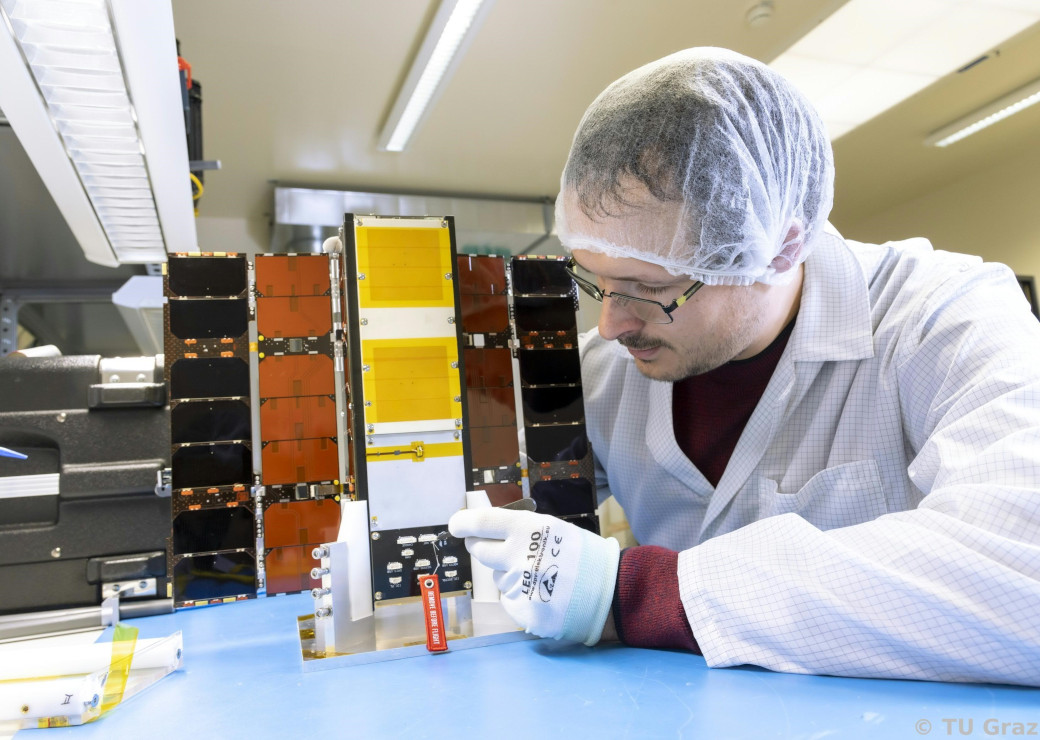Ready for space: Austrian ESA satellite PRETTY is ready for launch
The next Austrian satellite has been built and tested and is ready for launch into orbit in spring 2023: PRETTY will be the fifth Austrian satellite in space, the third made and tested by TU Graz. The customer for the climate observation satellite is the European Space Agency ESA. Beyond Gravity Austria (formerly RUAG Space) is responsible for the overall project management.
PRETTY stands for Passive REflectomeTry and DosimeTrY and will fly two scientific experiments as payload:
The centerpiece is a passive reflectometer system for precise measurement of the Earth's surfaces, developed by Beyond Gravity Austria (concept and software system) and the Institute for Communication Networks and Satellite Communication at TU Graz (hardware). The small satellite will use it to measure the extent of ice and sea heights as well as ocean currents.
The second payload is a radiation detector for insights and knowledge on solar activity and space weather from Seibersdorf Labor GmbH. TU Graz also contributes the satellite platform, performed the manufacturing, assembly, integration and testing activities and will be responsible for the operation of the satellite with the ground station at Campus Inffeldgasse.
First milestone destination: Czech Republic
PRETTY is scheduled to launch into space in spring 2023 aboard a European Vega-C rocket from the European spaceport in Kourou, French Guiana, South America. The satellite's first milestone destination is Brno, Czech Republic. There, PRETTY will be placed in the launch vehicle by the launch provider along with other satellites, which will then be flown to Kourou.
Cubesat weighing just under five kilograms
PRETTY is a cubesat measuring 10x10x34 centimeters. The fold-out solar panels each have an area of 30x20 centimeters and supply the satellite with an average power of 24 watts. The satellite has a mass of 4.6 kilograms and will orbit the Earth in a polar orbit at an altitude of about 565 kilometers. PRETTY will communicate at data rates of up to 2 Mbit/s; PRETTY will be operated with the help of the ground station at Graz University of Technology.
The mission is designed to last at least one year. At the end of the mission, PRETTY will naturally re-enter the Earth's atmosphere and burn up. The satellite complies with ESA and UN guidelines for minimizing space debris.
Austrian satellites in space
PRETTY will be the fifth red-white-red satellite in space, and the third from the laboratories of TU Graz. The previous Austrian satellites (all small satellites) at a glance:
- TUGSAT-1/BRITE-Austria of the TU Graz
- UniBRITE from the University of Vienna (TUGSAT-1 and UniBRITE are part of a fleet of five nano-satellites that measure variations in the brightness of stars; both have been in space since 2013)
- PEGASUS of the University of Applied Sciences Wiener Neustadt (studies the composition of the Earth's atmosphere; in space since 2017)
- OPS-SAT of TU Graz (tests and validates new techniques in mission control and on-board systems, ESA's first nanosatellite mission; in space since 2019)
PRETTY project consortium
- Beyond Gravity Austria GmbH (formerly RUAG Space GmbH)
- TU Graz - Institute of Communication Networks and Satellite Communications
- Seibersdorf Labor GmbH
- European Space Agency (ESA)
Kontakt
TU Graz
Susanne Filzwieser
Communications and Marketing
E-Mail: susanne.filzwieser@tugraz.at
Web: www.tugraz.at
Beyond Gravity Austria
Christian Thalmayr
Corporate Communications
E-Mail: christian.thalmayr@beyondgravity.com
Web: www.beyondgravity.com

